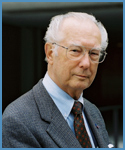

Interview with Watt Webb

IDEX Health & Science: Your early career focused on metallurgy and solid-state physics (super-conducting magnets) and now is almost exclusively focused on the life sciences and their instrumentation. Was this a natural scientific progression or did you see something that (leaning to his inherent scientific curiosity) others didn't?
Watt Webb: Well, I originally started out as a horse wrangler, albeit when I was only nine years old. After that I worked in the family banking business and was required to enroll in the business school at MIT when I chose that institution, even though I had wanted to be a Naval architect. However, after graduating I worked for Union Carbide in their metallurgy division in Niagara, NY. Initially, I worked on submerged arc welding but eventually was measuring the temperature of the arc plasma generated in the submerged arc. That atomic physics motivated my return to graduate school for a ScD degree, and then I came back to Union Carbide to manage an R&D division.
IDEX Health & Science: What was the attraction in leaving an industrial-based role (with Union Carbide) to jump back into academia at Cornell?
Watt Webb: Cornell University was looking for someone to teach condensed matter theory, particularly, dislocation theory, which very few knew about back then. However, I had substantial research background in this topic and liked the invitation of Cornell. The opportunity to study continuous phase transitions (CPTs) also presented itself there, as an exciting topic in solid state physics at that time. These phase transitions led me into the life sciences.
I should mention that it was my applications of theory of dislocations and of CPTs plus the study of transition metals that enabled Mac Beasley and I to create the Niobium Titanium (NbTi), superconducting magnets still used today in MRI machines. Continuous phase transitions are found not only in solid state systems, they are actually common in biology. One example is the binding of the two strands of DNA that twist together in a helical configuration. The experimental methods theory that Elliot Elson and I derived and called "Fluorescence Correlation Spectroscopy" was relatively straightforward. However, experimental realization was not, until we used a drug (ethidium) to infiltrate the two DNA strands and dissociate them. What we found was that the compound then fluoresced as ethidium bromide. Thus, we used the fluorescence as the signal to monitor the reaction kinetics and binding, for which it is now widely used.
IDEX Health & Science: Pioneering work by your Cornell group has led to three significant advancements in optical sciences, namely fluorescence correlation spectroscopy (FCS) and multi-photon microscopy (MPM) and now optical approaches (using zero-mode waveguides) for nucleic acid sequencing. Which of these three discoveries was the most satisfying and why?
Watt Webb: Nothing that we've discussed today was not satisfying – everything we have done here was, and still is exciting!
Multi-photon microscopy (MPM) was really a development from the fundamental principles of energy conservation that Albert Einstein talked about, with the addition of elegant optics for focusing the laser light beam and filtering the excited fluorescence. Semrock has fortunately become an excellent source of optical filters for MPM!
Optical approaches to DNA sequencing were another very interesting and enlightening scientific path. We had nanoscale "Zero Mode Waveguides" (50nm across so that visible light only penetrated them to ~20nm) confining light to extremely small, zeptoliter, volumes. A new graduate student in my group – Jonas Korlach – was interested in DNA sequencing and came up with the use of 4 optical markers on the nucleotides to sequence DNA. We formed a team of the right people and thought about watching DNA polymerase form the DNA strand. Mounting DNA polymerase in a Zero Mode Waveguide (ZMW) and strategically tagging a fluorophore on each nucleotide allows the tagged DNA to form inside the waveguide structures illuminated by a spot of light to excite the emitted fluorescence as each base is attached. Again, what was most interesting and satisfying is that we started with core technologies and by bringing together people with creative thinking, solved a very challenging scientific question.
IDEX Health & Science: MPM technology continues to advance and find increasing use in medical applications. What are the current challenges faced by the MPM field and where do you see this technology going?
Watt Webb: Do you know that MP laser illumination will make you light up with your own intrinsic fluorescence?
IDEX Health & Science: Yes. I'm aware that a person will emit light up under the right laser illumination conditions.
Watt Webb: Well, the beauty of MPM applied to medicine is that no dye molecule additions are required. One can simply use the fluorescence properties of human tissue for human diagnostics. A very interesting example is the use of MPM to advance our understanding and diagnosis of bladder cancer. Cornell is developing MPM endoscopes that will not only allow doctors to locate cancerous tumors but also provide diagnostic mapping capabilities. This is a very promising "real-world" application of the MP technique and we are actively working with our partners at Weill Cornell Medical College in NYC, who are also excited about the potential of MP in the identification and treatment of cancers
IDEX Health & Science: You also have an active role in creating efficient DNA sequencing methods via the Scientific Advisory Board of Pacific Biosciences. Where do you see the role of academic researchers in helping to drive scientific/technology breakthroughs that can impact mankind?
Watt Webb: Based purely on my own experience there exist two key issues, namely: (1) that all new technology developed is made both accessible and available and (2) that more companies are ready to take on the challenge.
This is an ideal example of human benefits of academic research. The Pacific Biosciences methods were created by our collaborating group at Cornell and were enabled by our invention of the Zero Mode Waveguides, etc.
IDEX Health & Science: Who has had the most influence on your career and work?
Watt Webb: Virtually everybody that I've ever had the pleasure of engaging in research with!
